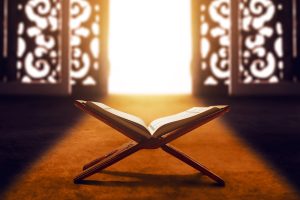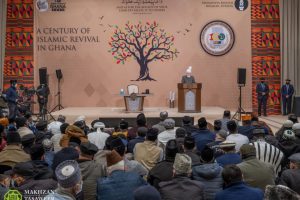Islam means peace and submission to the will of God. In Islam, various forms of expression have been used to inspire believers towards devotion to God. Individuals with harmonious and strong voices are selected to recite the call to prayer, drawing worshipers towards the mosque five times a day. Similarly, architectural elements and geometric patterns have been used throughout the Islamic world to beautify mosques and monuments related to holy sites.

The Review of Religions
Islamic calligraphy flourished in the same light. Its importance was amplified in the early centuries of Islam by one fundamental cause, the written transmission of the Holy Qur’an. During the life of the Holy Prophet Muhammadsa, the Qur’an was transmitted orally. It was not until after the Holy Prophetsa that the importance of calligraphy grew, in order to match the exponential growth of Islam in distant lands.
The Review of Religions’ exhibition at the Ahmadiyya Muslim Community’s 51st annual convention provided a glimpse into the world of Islamic calligraphy, showcasing a stunning variety of calligraphic forms over the last 1400 years, from the private collection of Razwan Baig (see page 24 for more information). Numerous civilisations, cultures and individuals have added to and expanded upon Islamic calligraphy, making it arguably the most diverse and extensive form of calligraphy in the world. Even today, Islamic calligraphy continues to inspire and serve as a form of devotion.
The Review of Religions’ exhibitions have centred on calligraphy and the Qur’an, showcasing rare and world-class pieces of Islamic art from around the world, spanning over one thousand years of history. Complementing the exhibition, a seminar series invited scholars and experts on
Islamic art and history to delve into the latest research in academia.
While many Ahmadi Muslims lined up to attend the Shroud Conference (see page 31 for more), others attended a trio of intriguing talks by renowned collector Razwan Baig and scholars Okasha el Daly, a leading expert in Egyptology and Medieval Arabic and an honorary lecturer at UCL Institute of Archaeology and Hany Rashwan, Ph.D. in Cultural, Literary and Postcolonial Studies. The talks explored intriguing developments in Islamic scholarship.

The Review of Religions
Collector Razwan Baig is well-known for his Islamic art collection, encompassing hundreds of significant ancient artefacts and copies of the Qur’an from various eras, showcasing the evolution and development of Islamic calligraphy. His talks focused on Islam’s artistic heritage: ‘I believe that art can build bridges between our cultural islands…Being an avid collector of Islamic art, I felt it was my humble duty to showcase the artistic side of Islam through my humble knowledge and collections.’ He explained the varying styles or scripts of calligraphy developed within Islamic calligraphic culture, each unique and highly sophisticated. Baig also mentioned that in the modern digital age, Islamic calligraphy has taken on new dimensions. Typefaces and fonts have drawn from calligraphic styles, inspiring individuals such as Steve Jobs—the founder of Apple—to create many of the font-types used today. Baig, indeed, has taken his extensive collection to many museums, such as the British Museum, and has partnered with The Review of Religions as well to make sure that a wider audience becomes aware of Islam’s rich artistic heritage. Indeed, his founding of the Al-Qalam Project (see our December 2017 issue) was another way to promote the art of Islamic calligraphy.
While Baig focused on the use of calligraphy to beautify the text of a Qur’an, Hany Rashwan discussed the rhetoric of that text. Rhetoric, in this context, refers to effective or persuasive writing, and the manner in which text or speech is composed. Dr Rashwan’s insights provided an important context to the current study of the Qur’an and its understanding in a western context. Western scholarship has attempted to understand Arabic, and
the Qur’an, through western concepts of rhetoric. As a result, the Qur’an has been heavily criticised for employing techniques which, in the Greco-Roman conventions of rhetoric, would be considered poor use of expression or language. However, Dr Rashwan criticised this approach for its reliance on western techniques at critiquing a non-western text. Arabic, Dr Rashwan pointed out, derives from a separate linguistic branch and must be understood in its context. Rashwan’s talk explored the idea that Western scholars, having elevated Greco-Roman notions of rhetoric as more sophisticated than other language systems, have done Arabic—and its other cousins in the Semitic and Afro-Asiatic language family—a grave disservice by judging it by those Greco-Roman standards, instead of trying to understand it through its own grammatical structures.

The Review of Religions
Take, for example, the concept of balagha, which is derived directly from the Qur’an where repetition of words is used to convey greater emphasis and a deeper meaning. In western languages, repetition of words is not considered to be eloquent speech. Instead, English writers are encouraged not to repeat themselves and to use synonyms and vary their word patterns in order to not have unnecessary repetition. Yet in the balagha system of repetition is actually used as a tool to provide emphasis and clarity and to enhance expression, and is also considered to have a musical quality, one that cannot be reproduced in western languages. So western scholars would do well to really understand the nuances and structures of non-western languages to analyse them in the light of their own systems. Dr Rashwan explained the different types of Arabic balagha and how it is not possible to fully understand the language using the rhetoric of other languages. He further elaborates that even changes in the vowels have a profound effect in the meaning. Similarly changes in the order may alter the meaning completely too.
He concluded by saying ‘Studying literary devices of the Qur’an or of Arabic in general has been affected negatively by imposing the Western methodology to understand its techniques and we should not be trapped in automatic application in the background of the scholar but we should incorporate different methodology to understand the inimitability of the Qur’an and how it is created in comparison to other texts.’

The Review of Religions
While Islam may have a rich artistic and linguistic legacy, what is its attitude towards the intellectual and cultural treasures of other cultures? Okasha el Daly explored this in depth in his discussion of how medieval Muslims were actually avid scholars of ancient (pre-Islamic) Egypt. He says: ‘Why did Muslim scholars in medieval times study ancient Egypt? They thought that if they unlocked the secrets to the ancient Egyptian language, you open the doors to a vast knowledge. This is because for Muslims, ancient Egypt was the land of science and magic.’ Indeed, while there is a misconception that Egyptology and the study of hieroglyphics is a relatively recent development in scholarship, the evidence suggests otherwise. El Daly cited the example of Champollion, widely considered to be the father of Egyptology. Yet Champollion studied the manuscripts of medieval Muslim scholars and even learned Arabic in order to learn from them.
Regrettably, in today’s world, Islam is known more for destroying the cultural richness of non-Muslim societies, rather than for preserving and enhancing culture due to the ill actions of a small minority of so-called Muslims. Yet, if one looks deeply into the language of the Qur’an and the scholarly heritage of ancient scholars, one will find that in fact, Islam has a rich history of both enhancing and appreciating the cultural legacy of non-Muslim societies.




Add Comment